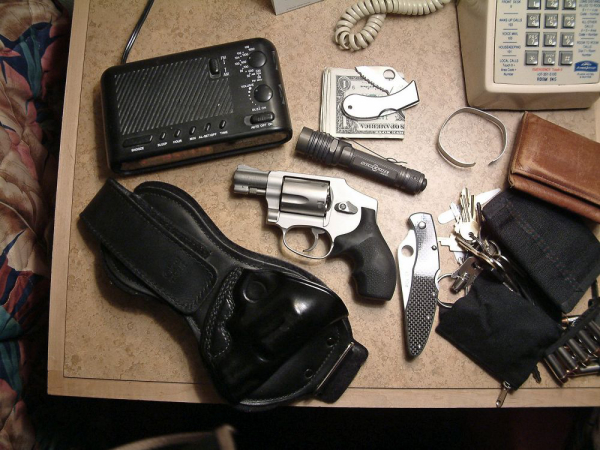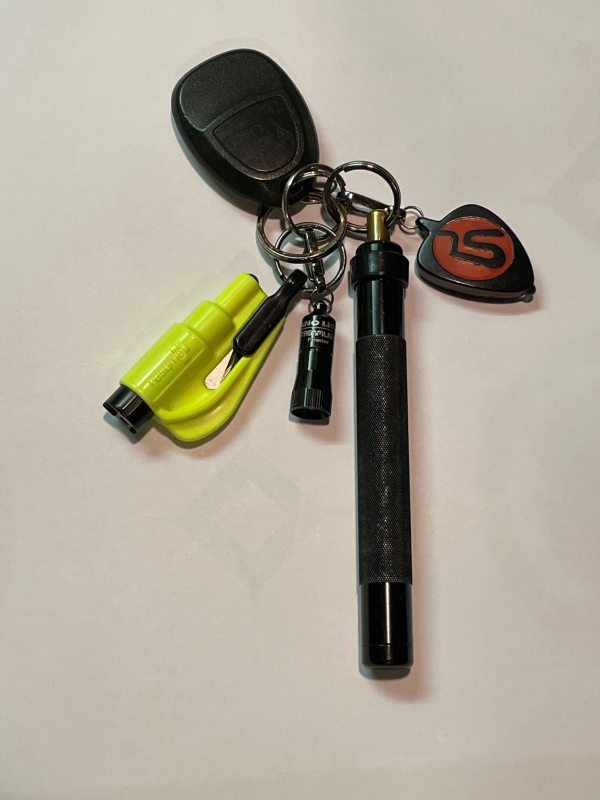Today’s feature is from correspondent Dave Spaulding.

As I advanced through my police career, I continually evaluated my individual readiness for conflict. I “war-gamed” potential scenarios, talked to my family about what to do, upgraded my weapons and everyday carry (EDC) gear and generally tried to stay prepared for the dangers that lurked on and off-duty. During several off-duty situations, I ran into people I had arrested. Recently, an older man walked up to me at Wal-Mart and told me he had just gotten out of prison after 20 years and I had put him there! I had no idea who he was until he told me (to all my cop and former cop friends…this can happen to you! You might not remember them, but they remember you!). It made for a few tense moments until he told me he harbored no animosity and wished me a Merry Christmas. This renewed my need to stay vigilant to the possibility of attack for no other reason than what I had done for a living.
Street cops are called “first responders” and I like the term. When trouble starts, and everyone else is running away, cops run into the fray no matter what the situation. As Lt. Col. Dave Grossman has stated, cops “run to the sound of the guns.” It’s what cops do, and I’m damn proud to say I’ve done it. That said, how many armed citizens could suddenly find themselves thrust into the role of first responder? In a time of 4th Generation warfare where every citizen is a possible combatant (according to our enemies) we must all be “active participants in our own rescue.”
I’ve been involved in a number of situations off-duty that had nothing to do with fighting and I had the proper state of mind to act instead of dither. I’ve helped traffic crash victims, found lost senior citizens, directed traffic until additional patrol units could arrive, pulled a drowning child from a pool, did CPR on a heart attack victim, treated a severe wound, talked to a suicidal subject and even cut away the trouser leg of a child whose pants got caught in an escalator. Yet with all of these situations, I never thought about my EDC carry gear being appropriate for anything other than armed conflict. A situation not too long ago, reaffirmed the need for everyone to be a potential first responder, to be ready for a wide variety of situations, whether cop or citizen, during the course of our everyday routine.
I read a story in the Salt Lake Tribune that gave me pause (Dec. 31, 2011: “Passers-by rescue children from submerged car in Utah river”). Three children were saved by passers-by after the car they were riding in lost control, fell down an embankment and landed upside-down in the icy Logan River. The 46-year-old driver was able to free himself, but the children, two nine-year-old girls and a four-year-old boy, were trapped in the freezing water. The doors of the car wouldn’t open, so a retired police officer named Chris Willden shot his Glock 23 through the window to break it. Passers-by then assembled, flipped the car over and helped pull the children out of the broken windows.
Although the youngest child wasn’t breathing when freed, he was resuscitated and flown to a hospital. The two girls were treated for hypothermia. Calibre Press founder Chuck Remsberg interviewed Willden later on PoliceOne.com. Willden offered these learning points to all who might face a similar circumstance.

Fellow trainer and good friend John Farnam stated Willden was one of his students. After talking with him about the incident, John stated: “There were several other well-meaning citizens present, who bravely endured the freezing waters that day. But only Willden was truly prepared! He had the necessary tools at hand and the boldness to unhesitatingly take unilateral, dicey, audacious action, not waiting around for ‘someone else’ to ‘do something. Through preparation and boldness, he snatched victory from the jaws of disaster.” Even though Willden is retired he rose to the occasion and took action when others didn’t. He was prepared mentally and had the gear he needed to accomplish the task.
How many of you can say the same? Could you stand back and watch three children drown? Nope, I couldn’t either! So, it’s smart to stay ready.
When it comes to EDC gear, what do you carry? Have you given it careful consideration based on your real world of work and play? Let’s examine the subject a bit. Like Willden, I carry a gun, knife and flashlight every day.
A Gun: It’s obvious—it’s a tool of personal security to be used when deadly force is reasonable based on the circumstances. In the case above, it was used as an impromptu window breaker…would you have thought of this? Would you know how to do it? True, not the best choice, but when nothing else will work, “Improvise, adapt and overcome.” My gun of choice: A Glock 19 in some type of Kydex belt holster and accompanying magazine pouch with a 15-round magazine loaded with Federal 147 grain HST hollow points. The G19 is compact enough to carry in all but the hottest weather, and is as reliable as any human-designed and engineered product can be.
Regardless of where you carry…carry!

A Folding Knife: It’s a cutting tool to me. Sure, it could be used as a weapon, but how many people can remove it from their pocket and get it open while under attack? Very few without extensive practice! Having cut a few people out of seat belts, I can tell you a knife is a handy thing to have. I can also tell you that not having a cutting tool when you need one is a gut-wrenching, hopeless feeling. How would you feel if you were in Willden’s place and had to watch those children perish because you had no way to cut them free? In recent years, I have started carrying a compact multi-tool and I must admit, it has been handier than a tactical folder.
A Flashlight: A flashlight doesn’t have to be a large or exceptionally bright light. It just needs to be able to search and navigate in bedroom-sized places. It just needs to be bright enough to find a light switch or find your way out of a smoke-filled room. I had the opportunity to hear one of the survivors of the 9-11 World Trade Center attack speak, and he made it quite clear that the people who had flashlights were able to find their way out of the smoldering buildings. Smoke, dust and other debris can easily fill the air to the point where the naked eye can’t see. Having a white-light source can mean the difference between life and death. Fortunately, many cell phones are now equipped with reasonably powered white lights.
A Cell Phone: Instant communication…a no-brainer. In this day and age, why would you be without one? I-Phone, Blackberry, Android? Who cares? Pick one.
First Aid Kit: The growing popularity and understood importance of Tactical Combat Casualty Care (TCCC) has made many folks think about what they can carry with them at all times that will address wounds. It's best to compromise and decide what is most likely needed for everyday use and keep it sleek.

Fitness: It’s great to have gear, but if you are not fit enough to take action then what is the point? You don’t need to look like an Olympic athlete to be considered “fit”, you just need to be able “to do”… to pull someone out of a window, run far enough to escape danger, climb a fence, pull yourself out of harm’s way, have a strong enough heart to withstand conflict, flexible enough to get through a tight space…you just never know. A big part of being able to “keep your head” in a crisis is keeping your heart rate low. My resting heart rate is 63 and I am 67 years old…it can be done. It requires effort, as do most things worth doing. Aging with health problems? Do your best.
The bottom line: As a possible first responder, whether you are law enforcement or a legally armed citizen, be prepared for a wide variety of situations, not just a gunfight. If you haven’t given careful consideration to your EDC gear, it’s time. Take a good look at what you need— someone’s life…or even your own…may depend on it.
Dave Spaulding is a professional firearms instructor with 36 years' experience in law enforcement and federal security. The recipient of the 2010 Law Enforcement Trainer of the Year Award from the International Law Enforcement Training and Educators Association, Dave has worked in all facets of law enforcement including communications, corrections, court security, patrol, evidence collection, training and investigations. He was a founding member of his agency’s SWAT Team and acted as its training officer for 8 years. He spent a year in an undercover capacity and was the commander of a multi-jurisdictional narcotics task force, has been an adjunct instructor at the former Heckler & Koch International Training Division and the Tactical Defense Institute. In addition to his many published articles (over 1,400), Dave is the author of two acclaimed books, Defensive Living and Handgun Combatives. He operated his own training company with focus on “the combative application of the handgun” www.handguncombatives.com.